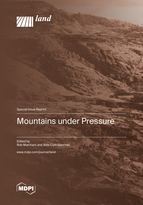Mountains under Pressure
A special issue of Land (ISSN 2073-445X). This special issue belongs to the section "Land Systems and Global Change".
Deadline for manuscript submissions: closed (30 September 2021) | Viewed by 59729
Special Issue Editors
Interests: tropical ecology; conservation; palaeoclimate; palaeoecology; fire ecology; modelling; management; sustainability
Special Issues, Collections and Topics in MDPI journals
Interests: tropical forest ecology; forest conservation; global environmental change; botany and ethnobotany; ecosystem services
Special Issue Information
Dear Colleagues,
Montane forests and alpine ecosystems are rich in biodiversity and endemism as well as being a large global carbon store. They are highly threatened by climate change, population growth and land use change. Mountains provide an ideal natural laboratory to investigate the evolution of social–ecological systems, and to assess the current challenges and opportunities that this past evolution has created. Mountains have been centres of past development and conduits for the spread of crops, populations and technologies. They were and remain a locus for cultural interaction, as manifested recently in many parts of the world at the local level through pastoral–agricultural–urban interactions over access to space and resources, particularly water. The relevance and impact of this Special Issue on mountains goes beyond academia, as practitioners and policy-makers need key information on the dynamics and changes in threatened ecosystems to help design and implement appropriate management strategies for sustainable mountain futures.
Prof. Dr. Rob Marchant
Dr. Aida Cuni-Sanchez
Guest Editors
Manuscript Submission Information
Manuscripts should be submitted online at www.mdpi.com by registering and logging in to this website. Once you are registered, click here to go to the submission form. Manuscripts can be submitted until the deadline. All submissions that pass pre-check are peer-reviewed. Accepted papers will be published continuously in the journal (as soon as accepted) and will be listed together on the special issue website. Research articles, review articles as well as short communications are invited. For planned papers, a title and short abstract (about 100 words) can be sent to the Editorial Office for announcement on this website.
Submitted manuscripts should not have been published previously, nor be under consideration for publication elsewhere (except conference proceedings papers). All manuscripts are thoroughly refereed through a single-blind peer-review process. A guide for authors and other relevant information for submission of manuscripts is available on the Instructions for Authors page. Land is an international peer-reviewed open access monthly journal published by MDPI.
Please visit the Instructions for Authors page before submitting a manuscript. The Article Processing Charge (APC) for publication in this open access journal is 2600 CHF (Swiss Francs). Submitted papers should be well formatted and use good English. Authors may use MDPI's English editing service prior to publication or during author revisions.
Keywords
- mountains
- social–ecological systems
- development
- cultural interaction
- pastoral–agricultural–urban interactions
- water
- conservation







